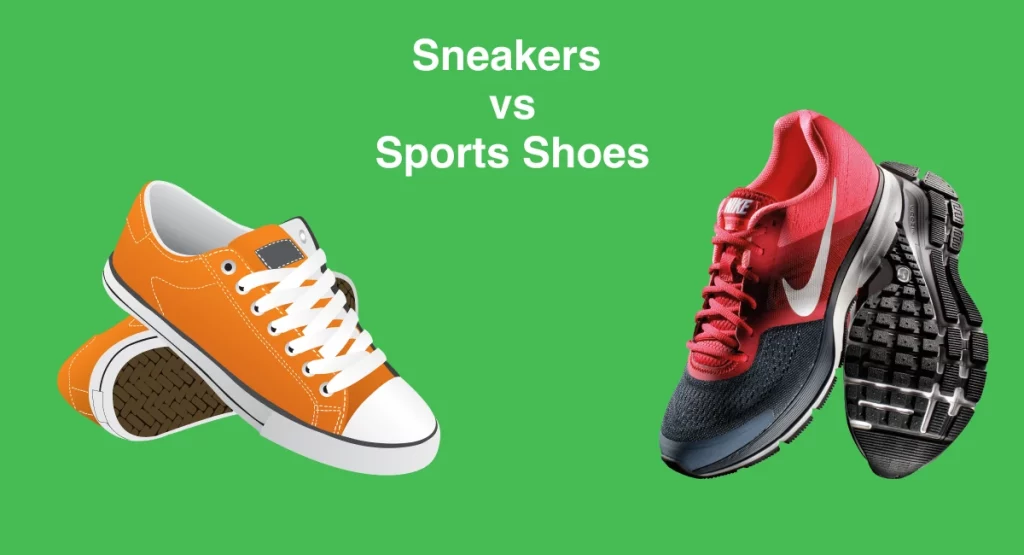We’ve all heard the term sneakers and sports shoes while shopping shoes. Understanding the differences between sneakers and sports shoes can be the key to making an informed decision. Here, we’ll explore the top 5 key differences between these popular footwear options, so you can confidently find the perfect match for your needs.

As someone who likes collecting shoes and has created a good collection, my friends often come to me with the same question. So I decided I’ll just share a complete guide around it so that it can help more people. So without any delay, let’s just on the key differences between sneakers and sports shoes.
Jump Directly To
Difference 1: Design and Aesthetics
Sneakers:
Sneakers come in various styles, from low-top and high-top designs to slip-ons and lace-ups. They often incorporate elements from street culture, art, and fashion trends, which make them highly sought-after by those who want to make a statement with their footwear.
Moreover, collaborations between popular brands and designers or celebrities have become increasingly common, resulting in limited-edition sneakers that are both fashionable and highly collectible. This fusion of style and comfort is a driving force behind the widespread appeal of sneakers.
Sports Shoes:
Sports shoes, while also available in different styles, prioritize function over form. They are designed with a clear focus on the demands of a specific sport, be it running, basketball, soccer, or tennis. This influences their aesthetics, with each type featuring unique design elements that cater to the sport’s needs.
For instance, running shoes often have lightweight, breathable materials and cushioning for comfort during long runs. Basketball shoes, on the other hand, may offer ankle support and improved traction for better performance on the court. Thus, the aesthetics of sports shoes are directly tied to their purpose, making them highly specialized in terms of design.

Difference 2: Functionality and Performance
Sneakers:
Sneakers, primarily designed for casual wear, offer comfort and style for everyday activities such as walking, shopping, or socializing with friends. While they can also be suitable for light physical activities, such as a leisurely stroll or a short workout, they typically lack the specialized features needed for intense sports or exercise. The cushioning and support offered by sneakers are generally sufficient for casual use but may not hold up well under more rigorous conditions.
Sports Shoes:
In contrast, sports shoes are engineered to enhance performance in specific sports and physical activities. They possess unique features tailored to the requirements of the sport, providing athletes with the necessary support, stability, and protection to excel in their chosen field. For example, running shoes are designed with shock absorption and arch support to minimize the risk of injury during long-distance runs. Similarly, soccer cleats offer excellent traction on the field and are built to withstand the rigors of the game.
Difference 3: Materials and Construction
Sneakers:
Sneakers generally prioritize comfort and style, which is reflected in their choice of materials. They often feature lightweight, breathable fabrics such as canvas, mesh, or synthetic materials for the upper, providing a comfortable fit and a casual look. Additionally, sneakers typically have soft, flexible soles made from rubber or foam, which offer a good balance of cushioning and durability for everyday use.
Sports Shoes:
In contrast, sports shoes focus on providing optimal support, protection, and performance for a specific sport or activity. As a result, they utilize more advanced and specialized materials tailored to the unique needs of the sport. For example, running shoes may incorporate lightweight, moisture-wicking fabrics and advanced cushioning materials like memory foam or gel to reduce impact and provide a comfortable fit during long runs. Basketball shoes, on the other hand, might use more robust materials like leather or synthetic overlays to ensure durability and support during intense gameplay.
Difference 4: Types and Varieties
Sneakers come in a wide array of styles and designs, reflecting the diversity of tastes and fashion trends. From classic low-tops and high-tops to contemporary slip-ons and chunky “dad” sneakers, there is a sneaker style for everyone. In addition, sneakers are available in various materials, colorways, and patterns, which allow for endless customization and personal expression. This vast assortment of options enables individuals to find the perfect pair of sneakers to match their unique sense of style and personal preferences.
On the other hand, sports shoes are categorized based on the specific sport or activity they are designed to support. Each type of sports shoe is tailored to meet the unique demands and performance requirements of its intended sport. Some common examples include:
- Running shoes – Designed for road or trail running, with features like cushioning, support, and traction.
- Basketball shoes – Built for stability, ankle support, and improved traction on the court.
- Soccer cleats – Offers excellent grip on the field and are designed to withstand the rigors of the game.
- Tennis shoes – Providing lateral support, cushioning, and durability for quick movements on the court.
- Cross-training shoes – Engineered for versatility, offering a balance of support, cushioning, and flexibility for various types of workouts.
Each of these sports shoe categories includes multiple models and variations, with options for different levels of skill, preferences, and budgets. However, the primary focus remains on performance and functionality, rather than fashion or personal expression.
Difference 5: Price Range and Brands
Sneakers
Sneakers encompass a wide price spectrum, ranging from affordable options to high-end designer collaborations. Budget-friendly sneaker brands like Bata, Campus, and Sparx offer stylish and comfortable footwear at accessible price points, making them popular choices among the Indian audience.
In contrast, premium and luxury brands like Nike, Adidas, Puma, and Reebok also have a strong presence in India, offering limited-edition sneakers, collaborations, and exclusive designs that cater to the more fashion-conscious and affluent consumers. This broad price range ensures that there is a sneaker option for everyone, regardless of their budget.
Sports Shoes
Sports shoes, while also available across various price points, typically emphasize performance and functionality, which can result in higher price tags compared to sneakers. Affordable sports shoe brands like Decathlon, Lancer, and Action provide budget-conscious consumers with functional and comfortable options for various sports and activities.
Meanwhile, international brands like Puma, ASICS, New Balance, Under Armour, and Skechers offer more advanced and specialized sports shoes, incorporating cutting-edge technology and materials that cater to serious athletes and sports enthusiasts. These performance-focused shoes often come at a higher cost, reflecting the research and development behind their innovative features.
Comparison: Difference Between Sneakers and Sports Shoes
| Characteristics | Sneakers | Sports Shoes |
|---|---|---|
| Design and Aesthetics | Stylish, trendy, and fashionable | Performance-oriented, sport-specific |
| Functionality | Casual wear, light physical activities | Designed for specific sports and activities |
| Performance | Comfort and style for everyday use | Enhanced support, stability, and protection |
| Materials and Construction | Lightweight, breathable fabrics | Specialized, advanced materials for support and durability |
| Types and Varieties | Wide array of styles and designs | Categorized by sport or activity |
| Price Range | Affordable to high-end designer options | Focus on performance, often higher-priced |
| Brands (Indian Market) | Converse, Vans, Bata, Campus, Sparx | Puma, Adidas, Nike, ASICS, New Balance |
Explore offers running on Puma Shoes:
- Upto 60% Discount On Puma Shoes
- Extra 10% OFF On Orders Above ₹3999
- Best Puma Running Shoes Under 5000 INR For Men



